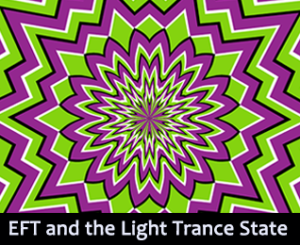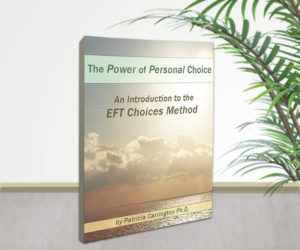 Many people look upon Emotional Freedom Techniques, also known as EFT or EFT Tapping, as inducing an altered state of consciousness (abbreviated as “ASC”), which is one of its most prominent and valuable features.
Many people look upon Emotional Freedom Techniques, also known as EFT or EFT Tapping, as inducing an altered state of consciousness (abbreviated as “ASC”), which is one of its most prominent and valuable features.
To some people, such a statement will conjure up images of psychedelic drugs, Shamanistic rituals, deep hypnotic trances, and similar extreme states. However, disillusion yourself from this interpretation.
It is obvious that all of the extreme states mentioned above do in fact result in ASC’s, it is important to realize that the OPPOSITE is not necessarily true. Not all ASC’s involve such extreme interventions or have such extreme consequences, in fact most of them don’t.
The altered state of consciousness in EFT is a normal light trance state. Again, don’t let this statement throw you because of the word “trance.” Unfortunately, that word often brings a negative image to mind. According to Webster’s dictionary, “trance” implies an inability to function or being in a state of daze or stupor. For this reason the light trances of everyday life (examples are below) are frequently confused with the trances of deep hypnosis, during which there is only limited contact with one’s surroundings and you may be quite unable, afterward, to recall what went on during the trance.
Those deep states are certain kinds of trance, to be sure, but in fact, they are neither the only ones nor the most prevalent. Light trance states, which are familiar to everyone, do not ordinarily possess alarming qualities. Dr. Ronald Shor, a specialist in hypnosis, has pointed out that these light trances are daily, commonplace occurrences for all of us. They simply involve a sharp narrowing of our attention that becomes focused on one, or only a few, objects or events or thoughts. Because of this narrowing of attention, our generalized reality-orientation — that is, our awareness of our surroundings and of our usual ways of thinking and perceiving — begins to fade, creating a “trance” effect. Shor describes his own experience with a spontaneous “everyday” trance this way:
“I was reading a rather difficult scientific book which required complete absorption of thought to follow the argument. I had lost myself in it and was unaware of the passage of time or my surroundings. Then without warning, something was intruding upon me, a vague, nebulous feeling of change. It all took place in a split-second and when it was over, I discovered that my wife had entered the room and addressed a remark to me. I was then able to call forth the remark itself which had somehow etched itself into my memory even though at the time it was spoken I was not aware of this.” (R. E. Schor, “Hypnosis and the concept of the generalized reality orientation” in Altered States of Consciousness, (C. T. Tart, Ed.). NY: Wiley, 1969, pp. 233-250)
Obviously, many other everyday occurrences involve entering a state of light trance, although we may not label the state we experience by that name. We all know, for example, how artists may become so intensely absorbed during their inspirational phase that they become almost oblivious to their surroundings. The same absorption can occur when we are deeply involved in viewing some majestic scene in nature or watching an engrossing game, or are on the edge of our seats at an intense movie, or are listening to music, or making love, or meditating… or (as in EFT) tapping repeatedly on different spots on our bodies. Does this mean that we should think of all these activities as being forms of “self-hypnosis?” Actually, that would be stretching that term very far indeed.
It has been obvious among those who have worked with healing modalities that most involve a very light trance, and that they rely upon such mild ASC’s for much of their effectiveness. In many of these states, there is a common increased receptiveness to the self-administered suggestions about the mental or physical behavior they want to bring about.
In particular, tapping methods induce a state of temporarily heightened suggestibility in the user, which can be extremely valuable. This is, in fact, the reason the Choices variation of EFT are so valuable — Choices are positive suggestions (affirmations), which seem to “instill” with amazing rapidity when repeated during EFT.
How EFT Brings about a Light Trance State
For one thing, it involves repetitive behavior – tapping and the repeating of certain phrases. Repetitive, or monotonous behaviors, have been used throughout the ages to induce a state of light trance. An example is the rhythmic repetition of a mantra in meditation, which is extremely effective for this purpose.
To illustrate one way in which light trance can develop during EFT, ponder this quote from a discussion contributed by my brother, Bob Carrington, about how the suggestibility factor enters the EFT process:
“A person using EFT taps lightly with his or her fingers on specially sensitive spots. This amazingly rapidly attunes the person’s body to a state of unique receptivity. In this state the user follows a carefully chosen pattern of words and phrases that “get through” to them on a very deep level. These words, the spoken message, penetrate to an exceptionally deep level because of the tapping, breaking through the “walled fortress,” which is present in every personality. This enables the user to make remarkable and highly desirable changes in lifestyle. EFT therefore brings about a profound form of change, change without thinking about it—deep, permanent change.”
To put it another way — the depth of the effect produced by EFT is the result of three different processes working together. They are:
- A state of high receptivity set off by the tapping, into which the body falls effortlessly.
- Repeating aloud specific, carefully designed messages by the person who is in this state — this repetition allows the body to deeply “hear” those messages.
- Reprogramming of the mind that must accommodate the new input
It is this final process, the reprogramming of the mind, that empowers EFT to make such desirable and far reaching personality changes.”
The essential point made here is that self suggestions are “getting through” during the tapping procedure in a remarkable manner and this has proven to be the case in literally thousands of instances of cases.
However, this does not mean that EFT’s beneficial effects are due ONLY to a suggestion process, not by any means. For example, they sometimes take place in the absence of any words at all, as when EFT is used with infants or animals, or in proxy or “surrogate” tapping by another person, where no words are spoken — to mention just a few of the variations that can occur with EFT.
With respect to installing positive suggestions in EFT, this is indeed possible. It is, in fact the basis for the Choices Method. This advanced form of EFT derives its importance from introducing the possibility of shaping behavior and attitudes in an extensive manner, converting it into a powerful method for personal growth.
Related Products
The Power of Personal Choice in EFT
You’ll find a basic introduction to the EFT Choices Method in this eBook and be well on your way to mastering this popular self-help technique.
Only $6.00








Hello Dr. Carrington. I am an EFT instructor and interestingly, one of the first things I discuss in my classes is the light trance state that goes along with EFT, in the same way you suggest.
I also want you to know that when working with clients, I use exclusively, the “choices” Method. I find it more empowering than traditional EFT and my clients do as well. It is the positive input that often makes the difference. I find it interesting that Craig does not consider positive EFT as a valid EFT process. When a client finishes on a positive note, the change is quick and lasting. Thanks for introducing it.